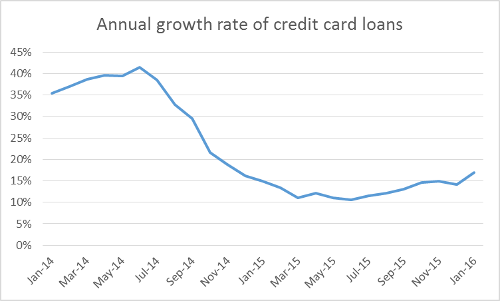Credit Card Law: protection or risk?

By Estefanía Luján Padilla April 21, 2016
Translated from Spanish by Katarina Hall
March is almost here and Guatemala’s credit card law will soon come into effect. The country’s banks have already been making the necessary changes to comply with the law to prevent delays. The law’s main objective is to end abuses on by the banks when it comes to collecting payment (interest rates and abusive collection practices). However, the law will have negative effects that have mostly gone unnoticed: a price increase in other financial services, and a displacement towards an informal and unregulated market.
The first effect is already visible. As of last week the banks have been announcing the modifications needed to comply with the law. The notices contain the new interest rates and new days of payment, as well as the new membership prices to access benefits, theft insurance, and fraud, among others. Of course, these new measures restrict credit card access for some; credit cards will be offered at higher prices, less people will demand them. This “positive” effect leads us to the second negative effect that is still invisible to most: the displacement by those who were unable to access the cards towards the unregulated lending market.
While it is true that interest rates were increasingly high, that persistent collection calls were annoying, and that credit card distribution was not measured, we can’t ignore the fact that the person who can’t obtain immediate credit with banks will find somewhere else to obtain it without the prerequisites of the law. Is it wrong for people to look for credit with other sources other than banks? No, as long as there is some kind of regulation or rules that establish credit limits and risk administration.
The Guatemalan banking system is widely known for its rigidity of rules, allowing it to be stable when it decrees minimum financial ratios that banks must hold to avoid liquidity and credit risks, among others. Moreover, Guatemalan banks are governed by international regulations—Basel I—that do not permit them to grant more than “15% of computable assets to a sole individual or legal entity (…), [or more than] 30% of computable assets to two or more related people that form part of a risk unit.”[1] However, these regulations apply only to banking institutions, financial corporations, warehousing, insurance firms, money exchange firms, brokerage firms, and financial groups. If a company is not registered as any of the aforementioned categories, the Superintendency of Banks (SIB) can’t regulate it. Such is the case of many companies that grant immediate credit of up to Q60 million in less than 24 hours.
These corporations are not only unregulated, but they have also received multiple lawsuits in recent years. They are sued because of their unmeasurable interest rates, collection call harassments, and because lenders en up paying more than 5 times the original amount borrowed. Ironic, isn’t it? The only difference between these lawsuits and those directed at banks is that the ones against banks have a defendant that the judicial system can pursue and due proess. When it comes to unregulated lending companies, they don’t have a normative base and in many cases they are not registered with the Company Registry. How can the due process of a lawsuit continue without a defendant? However, these risks are not the first thing to cross the lender’s mind when he needs credit. Lenders see the ease of borrowing high amounts in less than 24 hours with the need of nothing more than their Personal Identification Document (DPI), being over 25 years of age, and a warranty of a stable income. Who would not want to borrow without any major restrictions? But what is not shared with lenders is that these interest rates can reach up to 5% a day. How does this rate compare to the Credit Card Law regulation that prevents exceeding more than twice the average lending rate?
The law had as its main objective to protect the lender against the usurious banking institutions that charge high interest rates and harass beneficiaries through collection calls to get them to pay on time. But the law’s real effect will be to throw the low-income lenders to the wolves, where there is no regulation and rules. In this case, what other measure could have been adopted to avoid this abuse? No such measure would have to be adopted if the call centers did not harass lenders. This would not even be necessary if Guatemala’s judicial processes were respected and efficient. Yet this is not the case. Sentences in lawsuits for lack of payment take up to several months, even years. The same goes to high interest rates, which credit card collectors merely used as a method of filtering.
The credit card law brings about negative effects that only few have noticed: the price increase of complementary banking services and the flight of lenders from a regulated financial system to an unregulated one. To establish a law with these almost invisible collateral effects is unnecessary if the Rule of Law works as an efficient judicial system.
[1] Article 47 Concentration of investments and contingencies , Chapter II , Law on Banks and Financial Groups.
Get our free exclusive report on our unique methodology to predict recessions

Estefanía Luján Padilla
Estefanía Luján has a degree in Economics with a specialization in Finance from the Francisco Marroquín University. She has attended to summer seminars from the Institute Juan de Mariana and from the Institute for Humane Studies. At Universidad Francisco Marroquín, she was a teacher assistant of courses from Henry Hazlitt Center as well as from the School of Economics, where she is also the Directors Assistant of Economics.
Get our free exclusive report on our unique methodology to predict recessions




Great article, with plenty of much needed context for those unfamiliar with the Guatemalan banking system!
The law’s main objective is to end abuses on by the banks when it comes to collecting payment (interest rates and abusive collection practices). However, the law will have negative effects that have mostly gone unnoticed: a price increase in other financial services, and a displacement towards an informal and unregulated market.